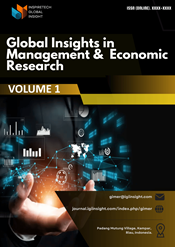Stimulating Tourists' Imagination: The Role of Visual Communication in Managing Storynomic Tourism Strategies in the Digital Age
DOI:
https://doi.org/10.53905/Gimer.v1i02.8Keywords:
visual communication, storynomic tourism, digital marketing, destination branding, visual storytelling, tourism strategy, social mediaAbstract
Purpose of the study: This research aims to analyse the role of visual communication in supporting storynomic tourism strategies, particularly how visual elements shape tourist perceptions, emotional connections, and destination attractiveness in the digital age.
Materials and methods: A qualitative-descriptive approach was employed, incorporating visual semiotics and representation discourse analysis. Data were collected through digital documentation of social media content, in-depth interviews with tourism content creators and digital travellers, and participatory online observation. Visual materials from Instagram, TikTok, and YouTube accounts (e.g., @wonderfulindonesia) were the primary objects of study.
Results: Findings reveal that visuals—through the use of local symbols, colour palettes, illustration styles, and cinematic storytelling—effectively build emotional narratives and trigger the imagination of digital travellers. Content infused with cultural meaning outperformed purely informational visuals in engagement metrics. Social media platforms such as Instagram and TikTok proved particularly powerful in conveying micro-narratives that inspire travel interest.
Conclusions: Visual storytelling is a critical component of storynomic tourism, influencing traveller decisions through emotional engagement and digital immersion. A research-based visual communication strategy that prioritises cultural authenticity and emotional resonance is essential for tourism stakeholders aiming to differentiate destinations in the competitive digital landscape.
References
Caton, L. (2019). Gillian rose, visual methodologies: an introduction to researching with visual materials. Journal of Early Childhood Literacy, 146879841989617. https://doi.org/10.1177/1468798419896175
Chakravarty, U., Chand, G., & Singh, U. N. (2021). Millennial travel vlogs: emergence of a new form of virtual tourism in the post-pandemic era?. Worldwide Hospitality and Tourism Themes, 13(5), 666-676. https://doi.org/10.1108/whatt-05-2021-0077
Cheng, Y., Wei, W., & Zhang, L. (2020). Seeing destinations through vlogs: implications for leveraging customer engagement behavior to increase travel intention. International Journal of Contemporary Hospitality Management, 32(10), 3227-3248. https://doi.org/10.1108/ijchm-04-2020-0319
Creswell, J.W. and Creswell, J.D. (2018) Research Design: Qualitative, Quantitative, and Mixed Methods Approaches. Sage, Los Angele
Govers, R. and Go, F. M. (2009). Place branding.. https://doi.org/10.1007/978-0-230-24702-4.
Green, M. C. and Brock, T. C. (2000). The role of transportation in the persuasiveness of public narratives.. Journal of Personality and Social Psychology, 79(5), 701-721. https://doi.org/10.1037/0022-3514.79.5.701.
Hans, J. S., Barthes, R., & Heath, S. (1978). Image-music-text. The Journal of Aesthetics and Art Criticism, 37(2), 235. https://doi.org/10.2307/429854.
Jacobsen, J. K. S. and Munar, A. M. (2012). Tourist information search and destination choice in a digital age. Tourism Management Perspectives, 1, 39-47. https://doi.org/10.1016/j.tmp.2011.12.005.
Jo, M., Cha, J., & Kim, J. (2022). The effects of tourism storytelling on tourism destination brand value, lovemarks and relationship strength in south korea. Sustainability, 14(24), 16495. https://doi.org/10.3390/su142416495
Júnior, J. R. d. O., Limongi, R., Lim, W. M., Eastman, J. K., & Kumar, S. (2022). A story to sell: the influence of storytelling on consumers' purchasing behavior. Psychology &Amp; Marketing, 40(2), 239-261. https://doi.org/10.1002/mar.21758
Kartajaya, H., & Kotler, P. (2021). Marketing 5.0: Technology for Humanity. Wiley.
Kim, J. and Youn, H. (2016). How to design and deliver stories about tourism destinations. Journal of Travel Research, 56(6), 808-820. https://doi.org/10.1177/0047287516666720
Li, T., Liao, C., Law, R., & Zhang, M. (2023). An integrated model of destination attractiveness and tourists’ environmentally responsible behavior: the mediating effect of place attachment. Behavioral Sciences, 13(3), 264. https://doi.org/10.3390/bs13030264
Mallick, S. U. (2023). Promoting tourism through digital marketing. The American Journal of Management and Economics Innovations, 5(10), 62-85. https://doi.org/10.37547/tajmei/volume05issue10-06
Poczta, J. and Rozmiarek, M. (2021). "krajoznawstwo” in relation to different forms of active and cognitive tourism. Journal of Education, Health and Sport, 11(11), 120-131. https://doi.org/10.12775/jehs.2021.11.11.011
Roth, R. E. (2020). Cartographic design as visual storytelling: synthesis and review of map-based narratives, genres, and tropes. The Cartographic Journal, 58(1), 83-114. https://doi.org/10.1080/00087041.2019.1633103
Shaheer, I., Lee, C., & Carr, N. (2021). Factors motivating working holiday travel: the case of latin american visitors to new zealand. Tourism and Hospitality Research, 21(3), 330-343. https://doi.org/10.1177/14673584211003630
Sudarmanto, J. A. (2023). Technical negotiations and phenomena: capturing social media, and enchantment in indonesian tourism. KnE Social Sciences. https://doi.org/10.18502/kss.v8i15.13919
Tang, V., Acedo, A., & Paìnho, M. (2021). Sense of place and the city: the case of non-native residents in lisbon. Journal of Spatial Information Science, (23), 125-155. https://doi.org/10.5311/josis.2021.23.165
Wang, Y. and Wei, H. (2022). The influence of destination promotion videos on residents’ sense of empowerment and support for tourism. Sage Open, 12(3). https://doi.org/10.1177/21582440221106730
Wen, Y., Dong, Z., Xue, J., Luo, L., & Xue, Y. (2023). Which visual elements on packaging affect perceived credibility? a case study of in vitro diagnostic kits. Heliyon, 9(6), e17239. https://doi.org/10.1016/j.heliyon.2023.e17239
Downloads
Published
Issue
Section
Categories
License
Copyright (c) 2025 Aliyah, Raden Asri Kartini, Amanda, Tik Tik Dewi Sartika (Author)

This work is licensed under a Creative Commons Attribution-ShareAlike 4.0 International License.






